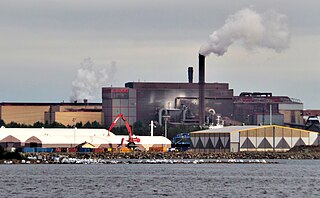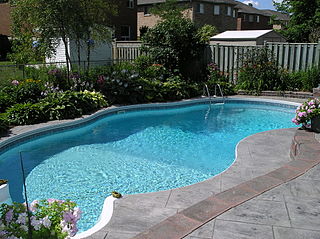Related Research Articles

Saccharin is an artificial sweetener with effectively no nutritional value. It is about 550 times as sweet as sucrose but has a bitter or metallic aftertaste, especially at high concentrations. Saccharin is used to sweeten products such as drinks, candies, cookies, and especially for masking bitter taste of some medicines.

Acesulfame potassium, also known as acesulfame K or Ace K, is a synthetic calorie-free sugar substitute often marketed under the trade names Sunett and Sweet One. In the European Union, it is known under the E number E950. It was discovered accidentally in 1967 by German chemist Karl Clauss at Hoechst AG. In chemical structure, acesulfame potassium is the potassium salt of 6-methyl-1,2,3-oxathiazine-4(3H)-one 2,2-dioxide. It is a white crystalline powder with molecular formula C
4H
4KNO
4S and a molecular weight of 201.24 g/mol.

The Royal Society of Chemistry (RSC) is a learned society in the United Kingdom with the goal of "advancing the chemical sciences". It was formed in 1980 from the amalgamation of the Chemical Society, the Royal Institute of Chemistry, the Faraday Society, and the Society for Analytical Chemistry with a new Royal Charter and the dual role of learned society and professional body. At its inception, the Society had a combined membership of 34,000 in the UK and a further 8,000 abroad. The headquarters of the Society are at Burlington House, Piccadilly, London. It also has offices in Thomas Graham House in Cambridge where RSC Publishing is based. The Society has offices in the United States at the University City Science Center, Philadelphia, in both Beijing and Shanghai, China and Bangalore, India.

Environmental chemistry is the scientific study of the chemical and biochemical phenomena that occur in natural places. It should not be confused with green chemistry, which seeks to reduce potential pollution at its source. It can be defined as the study of the sources, reactions, transport, effects, and fates of chemical species in the air, soil, and water environments; and the effect of human activity and biological activity on these. Environmental chemistry is an interdisciplinary science that includes atmospheric, aquatic and soil chemistry, as well as heavily relying on analytical chemistry and being related to environmental and other areas of science.
Monochloramine, often called chloramine, is the chemical compound with the formula NH2Cl. Together with dichloramine (NHCl2) and nitrogen trichloride (NCl3), it is one of the three chloramines of ammonia. It is a colorless liquid at its melting point of −66 °C (−87 °F), but it is usually handled as a dilute aqueous solution, in which form it is sometimes used as a disinfectant. Chloramine is too unstable to have its boiling point measured.
Urine-indicator dye is a mythical substance that is supposed to be able to react with urine to form a colored cloud in a swimming pool or hot tub, thus indicating the location of people who are urinating while they are in the water. A 2015 report from the National Swimming Pool Foundation called this "the most common pool myth of all time", with nearly half of Americans surveyed by researchers believing that the dye existed.
Swimming pool sanitation is the process of ensuring healthy conditions in swimming pools. Proper sanitation is needed to maintain the visual clarity of water and to prevent the transmission of infectious waterborne diseases.

A swimming pool service technician, known colloquially as a pool cleaner, is a tradesperson who cleans swimming pools and services major pool equipment such as pumps, motors, and filters.

A swimming pool, swimming bath, wading pool, paddling pool, or simply pool, is a structure designed to hold water to enable swimming or other leisure activities. Pools can be built into the ground or built above ground, and may be found as a feature aboard ocean-liners and cruise ships. In-ground pools are most commonly constructed from materials such as concrete, natural stone, metal, plastic, or fiberglass, and can be of a custom size and shape or built to a standardized size, the largest of which is the Olympic-size swimming pool.
In analytical chemistry, biomonitoring is the measurement of the body burden of toxic chemical compounds, elements, or their metabolites, in biological substances. Often, these measurements are done in blood and urine. Biomonitoring is performed in both environmental health, and in occupational safety and health as a means of exposure assessment and workplace health surveillance.
Linda Faye Nazar is a Senior Canada Research Chair in Solid State Materials and Distinguished Research Professor of Chemistry at the University of Waterloo. She develops materials for electrochemical energy storage and conversion. Nazar demonstrated that interwoven composites could be used to improve the energy density of lithium–sulphur batteries. She was awarded the 2019 Chemical Institute of Canada Medal.
Viola Ingrid Birss is a Professor of Chemistry at the University of Calgary. She works on electrochemistry and the development of nanomaterials for sustainable energy and sensing applications. She has demonstrated a metal oxide perovskite that can be used as the air and fuel electrode in solid oxide fuel cells, as well as creating nanoporous carbon scaffolds to be used in batteries and capacitors.
Miriam Diamond is an environmental chemist and a professor at the University of Toronto. She started the Professor Diamond's Environmental Research Group which works to develop strategies that reduce dangerous contaminants in the environment.

David S. Wishart is a Canadian researcher and a Distinguished University Professor in the Department of Biological Sciences and the Department of Computing Science at the University of Alberta, where he has been since 1995. Wishart also holds cross appointments in the Faculty of Pharmacy and Pharmaceutical Sciences and the Department of Laboratory Medicine and Pathology in the Faculty of Medicine and Dentistry. Additionally, Wishart holds a joint appointment in metabolomics at the Pacific Northwest National Laboratory in Richland, Washington. Wishart is well known for his pioneering contributions to the fields of protein NMR spectroscopy, bioinformatics, cheminformatics and metabolomics. In 2011, Wishart founded and currently serves as a co-director of the Metabolomics Innovation Centre (TMIC), which is Canada's national metabolomics laboratory.

Mary Anne White is a Canadian materials scientist who is the Harry Shirreff (Emerita) Professor of Chemical Research at Dalhousie University. Her research considers novel solar thermal materials and their application in renewable energy devices. She is the author of a textbook titled Physical Properties of Materials. She was appointed an Officer to the Order of Canada in 2016.
Myrna Simpson is a Canadian research chemist who is the Canada Research Chair in Integrative Molecular Biogeochemistry at the University of Toronto. She is also Director of the Environmental Nuclear Magnetic Resonance Centre. Her research consider the molecular level mechanisms that underpin environmental processes, and the development of advanced analytical tools to better understand environmental health.
Janusz Boleslaw Pawliszyn is a Polish chemist. He is a Canada Research Chair at the University of Waterloo and Natural Sciences and Engineering Research Council of Canada Industrial Research Chair in New Analytical Methods and Technologies.

Chuanyi Wang is a Chinese American, environmental chemistry scientist, academic, and an author. He is a Distinguished Professor and Academic Dean at the School of Environmental Science and Engineering at the Shaanxi University of Science & Technology. He is recognized for his research in environmental photocatalysis, environmental materials, surface/interface chemistry, nanomaterials, and pollution controlling.
References
- ↑ "Xing-Fang Li". Canada Research Chairs.
- ↑ "PRESS RELEASE | THE RSC PRESENTS THE CLASS OF 2021 | The Royal Society of Canada". rsc-src.ca. Retrieved 2022-04-04.
- 1 2 3 "2020 Ricardo Aroca Award". The Chemical Institute of Canada. Retrieved 2022-04-04.
- ↑ "Xing-Fang Li". scholar.google.ca. Retrieved 2022-04-04.
- 1 2 "How much pee is in the pool? New Alberta research measures water 'sweetness' | Globalnews.ca". Global News. Retrieved 2022-04-04.
- 1 2 Jmaiff Blackstock, Lindsay K.; Wang, Wei; Vemula, Sai; Jaeger, Benjamin T.; Li, Xing-Fang (2017-04-11). "Sweetened Swimming Pools and Hot Tubs". Environmental Science & Technology Letters. 4 (4): 149–153. doi:10.1021/acs.estlett.7b00043. S2CID 99475035.
- 1 2 "Artificial sweetener reveals how much pee is in the average pool". PBS NewsHour. 2017-03-03. Retrieved 2022-04-04.